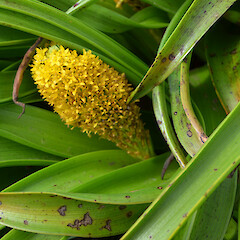Bulbinella rossii
Common name
Ross’s lily
Synonyms
Chrysobactron rossii Hook.f.; Anthericum rossii (Hook.f.) Hook.f.
Family
Asphodelaceae
Flora category
Vascular – Native
Endemic taxon
Yes
Endemic genus
No
Endemic family
No
Structural class
Herbs - Monocots
NVS code
The National Vegetation Survey (NVS) Databank is a physical archive and electronic databank containing records of over 94,000 vegetation survey plots - including data from over 19,000 permanent plots. NVS maintains a standard set of species code abbreviations that correspond to standard scientific plant names from the Ngä Tipu o Aotearoa - New Zealand Plants database.
BULROS
Chromosome number
2n = 14
Current conservation status
The conservation status of all known New Zealand vascular plant taxa at the rank of species and below were reassessed in 2017 using the New Zealand Threat Classification System (NZTCS) – more information about this can be found on the NZTCS website. This report includes a statistical summary and brief notes on changes since 2012 and replaces all previous NZTCS lists for vascular plants.
Please note, threat classifications are often suggested by authors when publications fall between NZTCS assessment periods – an interim threat classification status has not been assessed by the NZTCS panel.
- Conservation status of New Zealand indigenous vascular plants, 2017 . 2018. Peter J. de Lange, Jeremy R. Rolfe, John W. Barkla, Shannel P. Courtney, Paul D. Champion, Leon R. Perrie, Sarah M. Beadel, Kerry A. Ford, Ilse Breitwieser, Ines Schönberger, Rowan Hindmarsh-Walls, Peter B. Heenan and Kate Ladley. Department of Conservation. Source: NZTCS and licensed by DOC for reuse under the Creative Commons Attribution 4.0 International licence.
2017 | At Risk – Naturally Uncommon | Qualifiers: RR
Previous conservation statuses
2012 | At Risk – Naturally Uncommon | Qualifiers: RR
2009 | At Risk – Naturally Uncommon
2004 | Range Restricted
Distribution
Endemic. New Zealand: Auckland Islands and Campbell Island/Motu Ihupuku.
Habitat
Widespread and common from sea level to the tops of island ranges. Flourishes in disturbed sites, and so common near old habitations and because it is not especially palatable, where browsing animals congregate. prefers open herbfield and tussock grassland, where it may form dense colonies.
Wetland plant indicator status rating
Information derived from the revised national wetland plant list prepared to assist councils in delineating and monitoring wetlands (Clarkson et al., 2021 Manaaki Whenua – Landcare Research Contract Report LC3975 for Hawke’s Bay Regional Council). The national plant list categorises plants by the extent to which they are found in wetlands and not ‘drylands’. The indicator status ratings are OBL (obligate wetland), FACW (facultative wetland), FAC (facultative), FACU (facultative upland), and UPL (obligate upland). If you have suggestions for the Wetland Indicator Status Rating, please contact: [Enable JavaScript to view protected content]
FACW: Facultative Wetland
Usually is a hydrophyte but occasionally found in uplands (non-wetlands).
Detailed description
Dioecious, stout, perennial lily up to 1 m tall and 40 mm diameter at the base. Leaves fleshy, 0.6–1m x 15–60 mm wide, dark green, obtuse to subacute, apices recurved, nerves faint to prominent, easily felt when fresh. Peduncle up to 10 mm diameter, usually < leaf length. Inflorescence a cylindric raceme up to 150 × 600 mm; bracts and pedicels of almost equal length in female flowers and conspicuous in bud; in males < pedicels and inconspicuous in bud; pedicels 10–20 mm long, swollen just below flower. Flowers numerous, densely crowded, 10–14 mm diameter, golden yellow to sulphur yellow, often faintly tinged with orange; tepals oblong-ovate, spreading in males in females erect and remaining so, usually hardening as fruit ripens. Stamens < tepals; anthers in males conspicuously filled with pollen, in females rudimentary. Ovary 2 mm long, broad right to base. Capsule 10 mm long, broadly ovoid, gynophore absent. Seeds 4-6 mm long, dark brown to black, narrowly winged.
Similar taxa
None. This is the only species of Bulbinella Kunth present on the subantarctic islands. Bulbinella rossii is perhaps closest to B. gibbsii Cockayne, from which it differs by its greater stature, leaves up to 60 mm wide, cylindric rather than conical racemes held on a stout rather than slender axis which is obscured by the densely crowded flowers and fruits rather than more or less visible. Bulbinella rossii has a distinctly capitate rather than scarcely capitate stigma.
Flowering
October–January
Flower colours
Yellow
Fruiting
December–March
Life cycle
Winged seeds are dispersed by wind (Thorsen et al., 2009).
Propagation technique
Difficult—should not be removed from the wild. It has been cultivated with limited success in the more southerly parts of New Zealand.
Threats
No apparent threats. Listed because it occupies a small geographic area.
Etymology
bulbinella: Little bulb
rossii: Named for William Ross, a botanical collector; or Capt. James Ross, leader of an arctic expedition; or others named Ross, depending on genus
Attribution
Description modified by Peter de Lange from Moore and Edgar (1970)
References and further reading
Moore LB, Edgar E. 1970. Flora of New Zealand, Volume II. Indigenous Tracheophyta: Monocotyledones except Gramineae. Government Printer, Wellington, NZ. 354 p.
Thorsen MJ, Dickinson KJM, Seddon PJ. 2009. Seed dispersal systems in the New Zealand flora. Perspectives in Plant Ecology, Evolution and Systematics 11: 285–309. https://doi.org/10.1016/j.ppees.2009.06.001.
NZPCN Fact Sheet citation
Please cite as: de Lange, P.J. (Year at time of access): Bulbinella rossii Fact Sheet (content continuously updated). New Zealand Plant Conservation Network. https://www.nzpcn.org.nz/flora/species/bulbinella-rossii/ (Date website was queried)



















